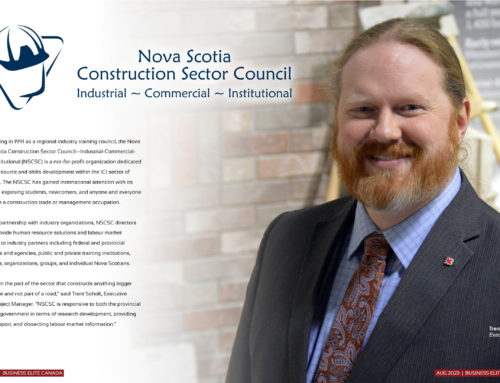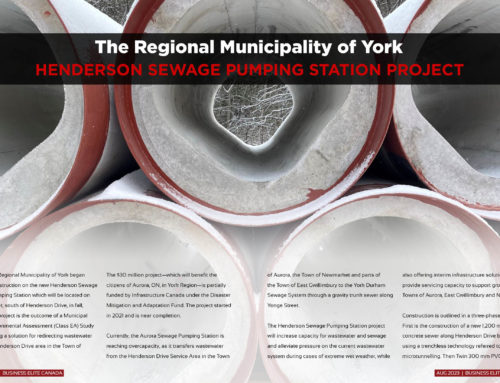“In it for the long run”
By Anna Guy
The Town of Marathon, ON, looms larger on the Canadian culture than its size would belie. A rural community of 3,500 in northern Ontario, its landscape is etched in the Canadian psyche from being portrayed in the iconic paintings of the Group of Seven who repeatedly painted the region in the 1920s.
Located in the Region of Thunder Bay along the north shore of the majestic Lake Superior, the town’s natural beauty is also the genesis of its prosperity, with the steady and well-managed use of its natural resources bringing eras of prosperity to the community through its modern history.
The town’s first main employer was the railway, which employed over 10,000 people in the 1880s. The population ebbed and flowed with economic development, entering its second boom in the 1940s with the arrival of the pulp and paper industry—it was during this time that the town officially got the name “Marathon”, after the paper company Marathon paper Mills of Canada Limited selected this site for the construction of a new pulp mill.
Marathon was a single-industry town until the 1980s when the richest gold discoveries the world has ever seen—and the richest ever found in Canada—was found in Marathon’s borders. The Hemlo Mines, the main mine sites to come out of the discovery, have since produced 6 million ounces, and have been controlled by Barrick Gold since 2010.
Gold Mine
“Barrick has a great economic impact to Marathon, and area,” says Mayor Rick Dumas. “Barrick have also been a great corporate citizen; they have made every effort to keep the community informed of changes in their operations. The mine is 35 years old and things are changing, there have been some recent layoffs at Hemlo but Barrick feels confident for the future of the Hemlo.”
Barrick’s Hemlo is still operational and developing gold so that is a good sign and will stay stable for a while, says Mayor Dumas. A main priority of the town is retaining youth in the community. “There is a migration of youth coming back and retirees staying here in the community, who are attracted to the low cost of living, proximity to regional capitals, and the quality of life,” he says. “We hope to stabilize that and continue moving forward.”
Big Picture Outlook
Operations are starting to wind down at the mine, but just like its name implies, Marathon is in it for the long run. Since his election as Mayor in 2006, Dumas has set his sights on the big picture, seeking out economic opportunities that will sustain the community for future generations.
To counter balance the expected reduced production at the Hemlo mines, the town Council is looking at diversification. Mayor Dumas says, “We have an opportunity with Generation Mining, which owns 51 per cent in a Marathon PGM ore body. And are currently investigating another potential mine which would mean up to 350 long-term jobs in the community.”
This year, Generation announced a “significant”, 18 per cent increase in the Mineral Resource Estimate for its Marathon Palladium property. The Marathon Deposit is the largest undeveloped Platinum Group Metal (“PGM”) Mineral Resource in North America.
According to Generation Mining, “The town of Marathon, where many of the employees of the nearby Hemlo gold mine reside, offers an excellent staging point for any future mine construction,” and is “located in close proximity to excellent infrastructure.”
The town’s dormant mill site is now a prime industrial site, one which the Town thinks would be beneficial to a number of sectors from new and advanced Forestry biomass, to Aquaculture. “It’s all over the map with regards to what we can bring here,” says the Mayor.
LNG
Building economic capacity, and promoting, attracting, and support growth: it’s the Alpha and Omega of the Council’s priorities. As a member of the North Shore LNG Project, the Town of Marathon is proposing to deliver Liquid Natural Gas (LNG) to home and businesses in the area though local infrastructure in each participating Municipality.
Currently awaiting approval from the Ontario Energy Board (OEB), for the North Shore communities of Lake Superior, LNG has the potential to bring significant social, economic and environmental benefits for residents and businesses and address the high cost of energy in rural communities.
Fibre Optic Connection
There’s also the $777-million East-West Tie transmission project, a proposed 450 km double-circuit 230 kV transmission line connecting the Lakehead Transfer Station in the Municipality of Shuniah near the city of Thunder Bay to the Wawa Transfer Station located east of the Municipality of Wawa. It will also connect to the Marathon Transformer Station.
Given the Green Light in January, 2019, construction officially began in October, 2019. The project is expected to have an average daily workforce of about 230 and 700 at the peak of construction.
“Economic development in the northwest, particularly in the mining and resource sector, is expected to drive strong electricity demand in the coming decade,” says Jennifer Tidmarsh, project director and president of NextEra Transmission Canada. “The East-West Tie Line Transmission Project is required to ensure the long-term reliability of the electricity supply in the northwest to power this growth.”
“We can continue looking at the resource sector, but we can look at the technology sector for those pockets of opportunity,” says Mayor Dumas. “We are talking to a lot of companies who we will go to bat for. I’m a believer that if you have a product or a technology or business model that you believe is successful, Marathon is your place.”
Looking out to the shore of Lake Ontario, Mayor Dumas says he also believes Marathon is one of the most beautiful places on Earth. “It’s like looking at the paintings we know so well, in front of your eyes. I know that people who move here often say that they should have come a lot earlier.”
www.marathon.ca






